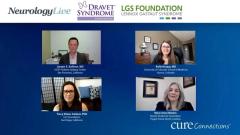
Treatment for Patients with Suboptimal Seizure Control
Joseph E. Sullivan, MD, and Kelly Knupp, MD, share strategies for managing patients who have suboptimal seizure control with medications.
Episodes in this series

Joseph E. Sullivan, MD: Now that we do have more medications, theoretically, we can get further down the lifespan even if everyone has this honeymoon effect. But ultimately, it is possible if there is a group of patients that are going to try most of the medications that we have available to us and still not achieve what we would consider a reasonable degree of seizure control. I'm curious Kelly, you mentioned ketogenic diet and other things, but other than the ones that we've already mentioned, I'm wondering what other strategies you use now, in 2022 when someone has, I don't want to say failed because they didn't fail, the medication's failed them. When a medication has failed them and didn't get them to a spot, where do you go from there?
Kelly Knupp, MD: Particularly for my older patients, it's important to go back and see what's been tried before and if something that was previously tried, in hindsight was more effective than they realized. Particularly for my older adolescent patients, that very well may be the case that there was something, oftentimes valproic acid had been tried earlier on and they didn't think it was helping, but then in hindsight they realized may have been more helpful than they realized, we may revisit that. Ketogenic diet, vagus nerve stimulator, as long as the family understands risk and benefits, I'll try any new medication that comes along. If it's a young woman who is having seizures around her menstrual cycle, we may think about manipulating the menstrual cycle. Doing some atypical things with medications. Our older patients with dravet often have seizures at night and not during the day, and so it may be that we give a bigger dose of the medication at bedtime and a very small dose or maybe no medication in the morning, they're seeing the benefit of the medication they are sleeping at night when they are more likely to have seizures. There are some other things that we haven’t talked about that are little atypical. Bromides have been helpful in some of those patients. Some of our newer medications that haven’t been tested in dravet syndrome something like perampanel, lacosamide. I have a handful of patients on lacosamide even though it’s a sodium channel blocker has been helpful for them. But all of that is a conversation with the family. We have little or no data on this on this patient population, this is an adverse effect profile, lacosamide to the atypical sodium channel blocker, let’s watch seizures and make sure they are not getting worse instead of getting better. But that’s always in partnership with the family.
Joseph E. Sullivan, MD: We touched on it before, having an identity, talking to other families, I have learned so much from my own families who are learning from other families. It is not appreciated but it does take a village and I couldn’t agree more. If I am nervous about something like perampanel, I have now done it a few times and it was largely based on a family saying this other family shared and as long as they – and I will say we are in this together, I need you to know, first time I am doing that. I also put my vulnerability out there and that’s just my style, but that is, it gets back to that shared decision making. But families appreciate – I don’t know, I shouldn’t speak as a family, Mary. How does that approach go with you?
Mary Anne Meskis: It’s greatly appreciated because when there is that recognition that a lot of this is unknown not just for the parents but also for the physicians and that you’re willing to work together as a collaborative care team, it means a lot to parents because they want to make sure that they have the information and they have the guidance but now that somebody is telling them this is what you should do without their input of how that will impact their daily lives.
Joseph E. Sullivan, MD: One thing that you had mentioned before – now we have patients that are quote-unquote out of options. You mentioned that there are still a lot of industry sponsors that have various clinical trial programs and I think I am incredibly grateful to all our family if you think about putting that trust in our hands as investigators, lot of unknowns. If they hadn’t done that, we wouldn’t have these 3 new compounds, so by encouraging participation in clinical research is a way that we can hopefully get more patients closer to that goal of seizure freedom and there is certainly some exciting pipeline therapies not only novel seizure medications, anti-seizure medications but some potential disease modifying therapies that were just starting to get some preliminary data. Hopefully when we do this again in a couple of years, we will be able to report back on how those are doing. What’s that?
Kelly Knupp, MD: We will have longer list of medications.
Joseph E. Sullivan, MD: Yes, exactly.
Transcript Edited for Clarity
Newsletter
Keep your finger on the pulse of neurology—subscribe to NeurologyLive for expert interviews, new data, and breakthrough treatment updates.





















